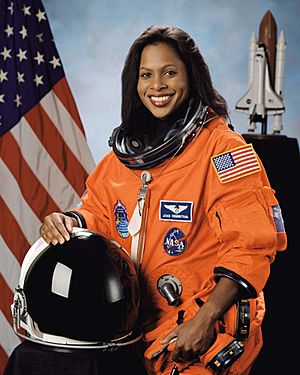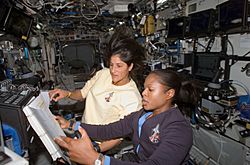Joan Higginbotham facts for kids
Quick facts for kids
Joan Higginbotham
|
|
|---|---|
 |
|
| Born | August 3, 1964 |
| Space career | |
| NASA astronaut | |
|
Time in space
|
12d 20h 45m |
| Selection | NASA Group 16 (1996) |
| Missions | STS-116 |
|
Mission insignia
|
|
Joan Elizabeth Higginbotham, born on August 3, 1964, is an amazing electrical engineer. She used to be a NASA astronaut. She flew into space on the Space Shuttle Discovery. This was during the STS-116 mission. She was a mission specialist on that flight. Joan is also the third African American woman to travel to space. She followed Mae Jemison and Stephanie Wilson.
Contents
Early Life and Education
Joan Higginbotham was born in Chicago, Illinois. She went to Whitney Young Magnet High School. She finished high school in 1982.
She earned her first college degree in 1987. This was a Bachelor of Science degree. She got it from Southern Illinois University Carbondale. Later, she earned two master's degrees. One was in management science in 1992. The other was in space systems in 1996. Both of these degrees came from the Florida Institute of Technology.
Joan is also a member of Delta Sigma Theta Sorority. She is also part of The Links, Incorporated.
Joan's Career at NASA

Joan Higginbotham started her career at NASA in 1987. This was just two weeks after she got her first college degree. She began working at the Kennedy Space Center (KSC) in Florida. Her first job was as a Payload Electrical Engineer. She worked with electrical and telecommunications systems.
Within six months, she became a lead engineer. She worked on experiments for the Space Shuttle Columbia. She also helped prepare the Space Shuttle's cargo area. She made sure all the equipment worked together. Joan also did special tasks for KSC management. She helped the Director of Shuttle Operations. She also led a team of engineers. They analyzed how the Space Shuttle was prepared for flights.
Later, she became a backup engineer for the Space Shuttle Atlantis. She helped connect the orbiter docking station. This was used for missions where the Shuttle connected with the Mir Space Station. Two years later, she became the lead engineer for the Space Shuttle Columbia. In this role, she was the main government engineer in the firing room. She helped manage vehicle testing and problem-solving. She was involved in 53 Space Shuttle launches. This was during her nine years at Kennedy Space Center.
Becoming an Astronaut
NASA chose Joan as an astronaut candidate in April 1996. She started her training at the Johnson Space Center in August 1996. After her training, she worked on many important projects. She worked with payloads and living areas in space. She also tested parts of the International Space Station (ISS). She made sure they would work correctly before launch.
Joan also worked as a CAPCOM (Capsule Communicator). This meant she talked to astronauts in space. She helped support many Space Station and Space Shuttle missions. She also worked with robotics. She was a lead for the ISS Systems Crew Interfaces Section. This involved how astronauts interact with the station's systems.
Her Space Mission
Joan Higginbotham spent over 308 hours in space. This was during her mission with the crew of STS-116. Her main job was to operate the Space Station Remote Manipulator System. This is also known as the Canadarm2. It is a robotic arm used to move things outside the ISS.
Joan was originally going to fly on the STS-126 mission in 2008. However, she decided to leave NASA. She took a job in the private sector. Donald Pettit took her place on the STS-126 mission.
Awards and Honors
Joan Higginbotham has received many awards for her work. Here are some of them:
- Group Award for achievements related to the flight of the STS-26. This was the first shuttle flight after the Challenger accident.
- NASA Exceptional Service Medal.
- Keys to the Cities of Cocoa and Rockledge, Florida.
- Women of Color in Technology Career Achievement Award.
- World Who's Who of Women.
- 1997 Distinguished Alumni, Florida Institute of Technology.
- 2004 Top 50 Women, Essence Magazine.
- 2007 Women in Space Science Award, Adler Planetarium.
- 2007 Black Rose Award, League of Black Women.
- 2008 Featured in "Bold Visions: Women in Science & Technology", a PBS special.
- 2014 50 Most Influential Women, The Mecklenburg Times.
- 2016 Honorary Doctor of Aerospace Science, Southern Illinois University at Carbondale.
- 2017 Honorary Doctor of Humane Letters, University of New Orleans.
- 2019 Featured speaker, TEDxBermuda.
See also
 In Spanish: Joan Higginbotham para niños
In Spanish: Joan Higginbotham para niños

